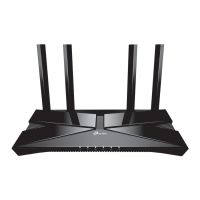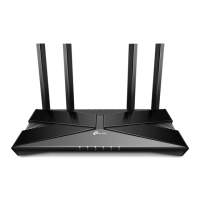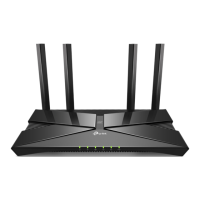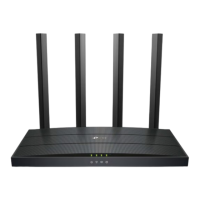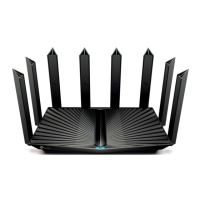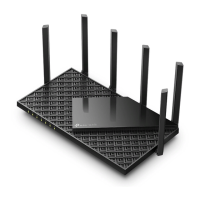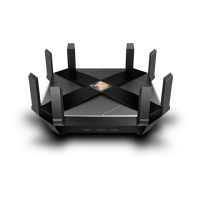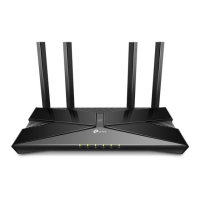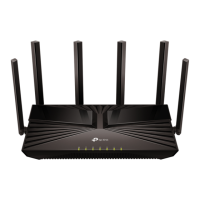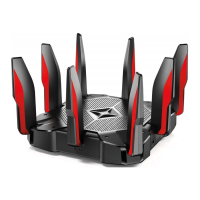Do you have a question about the TP-Link Archer AX75 and is the answer not in the manual?
Details the router's capabilities and its next-generation Wi-Fi 6 technology.
Details the LEDs and their functions located on the top panel of the router.
Illustrates and describes the ports and buttons on the back panel of the router.
Details the components located on the side panel of the router, including USB ports.
Guidance on optimal placement of the router for performance and safety.
Instructions for physically connecting the router to the modem and power source.
Steps to access the router's web management interface and set up an administrator password.
Step-by-step guide to configure the router's internet connection using the built-in wizard.
Instructions for setting up the router using the TP-Link Tether mobile application.
Procedure to configure internet connection settings manually based on ISP information.
Guide to configure the router to function as an access point for an existing network.
Steps to configure the router for an IPv6 internet connection as provided by the ISP.
Instructions on how to create a TP-Link ID for cloud management and remote access.
Steps to modify the email address and password associated with your TP-Link ID.
How to add or remove TP-Link IDs for managing the router, distinguishing between Admin and User roles.
Guide to using the TP-Link Tether app for managing the router remotely from mobile devices.
Customizing wireless network name (SSID), password, security options, and advanced settings.
Instructions for scheduling the wireless network to turn off automatically at specific times.
Methods for connecting devices to the wireless network using Wi-Fi Protected Setup (WPS).
Configuration of advanced wireless parameters like WMM, AP Isolation, and Airtime Fairness.
Steps to set up a separate Wi-Fi network for guests, customizing SSID and security.
Options to control guest network access, such as allowing clients to see each other or access the local network.
How to insert and access files on a USB storage device connected to the router locally or remotely.
Procedure for accessing USB storage devices from outside the local area network.
Configuring sharing accounts, specific content sharing, and custom server names for USB devices.
Enabling the feature to view media files from USB devices on DLNA-compatible devices.
Setting up the router to back up files from a Mac computer using Time Machine.
Utilizing HomeShield features for network protection against malicious attacks like intrusion and DDoS.
Setting restrictions on internet access for family members, including content blocking and time limits.
Using HomeShield tools for analyzing network performance, quality of service, and generating reports.
Instructions to enable and configure the OneMesh feature for a unified Wi-Fi network.
Viewing and managing devices connected to the OneMesh network via the router's web page.
Configuring the SPI Firewall to protect the router and network from unauthorized access and attacks.
Using Blacklist or Whitelist to block or allow specific devices' access to the network.
Binding IP addresses to MAC addresses to prevent ARP spoofing and related attacks.
Configuring Application Layer Gateway (ALG) settings for NAT traversal and specific protocols.
Setting up port forwarding to make local network services accessible from the internet.
Configuring port triggering to dynamically open specific external ports for applications.
Configuring a DMZ host to expose a PC to the internet with all ports open.
Enabling UPnP for seamless network connectivity for applications like online gaming.
Step-by-step guide to set up an OpenVPN server on the router for secure remote access.
Instructions to enable and configure a PPTP VPN server for remote access to the home network.
Modifying the router's LAN IP address and subnet mask for network configuration.
Setting up the router for IPTV/Phone service, including IGMP proxy and VLAN configuration.
Configuring the DHCP server settings, including IP address pool and address reservation.
Configuring DDNS to access the router remotely using a domain name instead of an IP address.
Manually configuring static routes for data packet forwarding between different network segments.
Procedures for updating the router's firmware, including auto and manual updates.
Saving router configuration settings and restoring them, including factory reset options.
Steps to change the password for accessing the router's web management page.
Enabling and configuring the password recovery feature for the router's login password.
Limiting access to the router from the LAN based on MAC address authentication.
Allowing or forbidding remote access to the router's management interface over the internet.
Saving system logs locally or sending them to an email address for troubleshooting.
Using diagnostic tools like Ping and Traceroute to test network connectivity.
Configuring the router's system time, time zone, and display language.
Scheduling automatic reboots for the router to maintain performance and clear cache.
Configuring the LED indicators, including enabling Night Mode to turn off LEDs during specific periods.
Details the router's capabilities and its next-generation Wi-Fi 6 technology.
Details the LEDs and their functions located on the top panel of the router.
Illustrates and describes the ports and buttons on the back panel of the router.
Details the components located on the side panel of the router, including USB ports.
Guidance on optimal placement of the router for performance and safety.
Instructions for physically connecting the router to the modem and power source.
Steps to access the router's web management interface and set up an administrator password.
Step-by-step guide to configure the router's internet connection using the built-in wizard.
Instructions for setting up the router using the TP-Link Tether mobile application.
Procedure to configure internet connection settings manually based on ISP information.
Guide to configure the router to function as an access point for an existing network.
Steps to configure the router for an IPv6 internet connection as provided by the ISP.
Instructions on how to create a TP-Link ID for cloud management and remote access.
Steps to modify the email address and password associated with your TP-Link ID.
How to add or remove TP-Link IDs for managing the router, distinguishing between Admin and User roles.
Guide to using the TP-Link Tether app for managing the router remotely from mobile devices.
Customizing wireless network name (SSID), password, security options, and advanced settings.
Instructions for scheduling the wireless network to turn off automatically at specific times.
Methods for connecting devices to the wireless network using Wi-Fi Protected Setup (WPS).
Configuration of advanced wireless parameters like WMM, AP Isolation, and Airtime Fairness.
Steps to set up a separate Wi-Fi network for guests, customizing SSID and security.
Options to control guest network access, such as allowing clients to see each other or access the local network.
How to insert and access files on a USB storage device connected to the router locally or remotely.
Procedure for accessing USB storage devices from outside the local area network.
Configuring sharing accounts, specific content sharing, and custom server names for USB devices.
Enabling the feature to view media files from USB devices on DLNA-compatible devices.
Setting up the router to back up files from a Mac computer using Time Machine.
Utilizing HomeShield features for network protection against malicious attacks like intrusion and DDoS.
Setting restrictions on internet access for family members, including content blocking and time limits.
Using HomeShield tools for analyzing network performance, quality of service, and generating reports.
Instructions to enable and configure the OneMesh feature for a unified Wi-Fi network.
Viewing and managing devices connected to the OneMesh network via the router's web page.
Configuring the SPI Firewall to protect the router and network from unauthorized access and attacks.
Using Blacklist or Whitelist to block or allow specific devices' access to the network.
Binding IP addresses to MAC addresses to prevent ARP spoofing and related attacks.
Configuring Application Layer Gateway (ALG) settings for NAT traversal and specific protocols.
Setting up port forwarding to make local network services accessible from the internet.
Configuring port triggering to dynamically open specific external ports for applications.
Configuring a DMZ host to expose a PC to the internet with all ports open.
Enabling UPnP for seamless network connectivity for applications like online gaming.
Step-by-step guide to set up an OpenVPN server on the router for secure remote access.
Instructions to enable and configure a PPTP VPN server for remote access to the home network.
Modifying the router's LAN IP address and subnet mask for network configuration.
Setting up the router for IPTV/Phone service, including IGMP proxy and VLAN configuration.
Configuring the DHCP server settings, including IP address pool and address reservation.
Configuring DDNS to access the router remotely using a domain name instead of an IP address.
Manually configuring static routes for data packet forwarding between different network segments.
Procedures for updating the router's firmware, including auto and manual updates.
Saving router configuration settings and restoring them, including factory reset options.
Steps to change the password for accessing the router's web management page.
Enabling and configuring the password recovery feature for the router's login password.
Limiting access to the router from the LAN based on MAC address authentication.
Allowing or forbidding remote access to the router's management interface over the internet.
Saving system logs locally or sending them to an email address for troubleshooting.
Using diagnostic tools like Ping and Traceroute to test network connectivity.
Configuring the router's system time, time zone, and display language.
Scheduling automatic reboots for the router to maintain performance and clear cache.
Configuring the LED indicators, including enabling Night Mode to turn off LEDs during specific periods.
| DSL WAN | No |
|---|---|
| Ethernet WAN | Yes |
| WAN connection type | RJ-45 |
| Modulation | OFDM |
| Wi-Fi band | Tri-band (2.4 GHz / 5 GHz / 5 GHz) |
| Wi-Fi standards | 802.11a, 802.11b, 802.11g, Wi-Fi 4 (802.11n), Wi-Fi 5 (802.11ac), Wi-Fi 6 (802.11ax) |
| Top Wi-Fi standard | Wi-Fi 6 (802.11ax) |
| WLAN data transfer rate (max) | 2402 Mbit/s |
| WLAN data transfer rate (first band) | 574 Mbit/s |
| VPN server | OpenVPN, PPTP, L2TP |
| Cabling technology | 10/100/1000Base-T(X) |
| Networking standards | IEEE 802.11a, IEEE 802.11ac, IEEE 802.11ax, IEEE 802.11b, IEEE 802.11g, IEEE 802.11n |
| Receiver sensitivity | 2.4 GHz: 11ac VHT20 MCS0 -97dBm, 11ac VHT20 MCS11 -66dBm, 11ac VHT40 MCS0 -95dBm, 11ac VHT40 MCS11 -64dBm, 11ax HE20 MCS0 -95dBm, 11ax HE20 MCS11 -64dBm, 11ax HE40 MCS0:-92dBm, 11ac HE40 MCS11:-62dBm 5 GHz: 11ac VHT20 MCS0-91dBm, 11ac VHT20 MCS11-60dBm, 11ac VHT40 MCS0 -89dBm, 11ac VHT40 MCS11 -57dBm, 11ac VHT80 MCS0 -86dBm, 11ac VHT80 MCS11 -54dBm, 11ac VHT160 MCS0 -84dBm, 11ac VHT160 MCS11 -53dBm, 11ax HE20 MCS0 -90dBm, 11ax HE20 MCS11 -60dBm, 11ax HE40 MCS0-88dBm, 11ax HE40 MCS11-57dBm, 11ax HE80 MCS0 -85dBm, 11ax HE80 MCS11 -54dBm, 11ax HE160 MCS0 -83dBm, 11ax HE160 MCS11 -53dBm |
| Ethernet LAN data rates | 10, 100, 1000 Mbit/s |
| Ethernet LAN interface type | Gigabit Ethernet |
| Number of guest networks (5 GHz) | 2 |
| Number of guest networks (2.4 GHz) | 1 |
| Mobile network generation | - |
| Ethernet LAN (RJ-45) ports | 4 |
| Security algorithms | WPA, WPA2, WPA2-Enterprise, WPA3 |
| Product type | Tabletop router |
| Product color | Black |
| LED indicators | Power, WLAN, WPS |
| Transmit power | \u003C24dBm (5.25GHz~5.35GHz&5.47GHz~5.725GHz), \u003C28dBm (5.15GHz~5.25GHz&5.725GHz~5.825GHz), \u003C29dBm (2.4GHz) dBmW |
| Antennas quantity | 6 |
| Internal memory | 512 MB |
| Processor frequency | 1700 MHz |
| Processor manufacturer | Broadcom |
| Output current | 2.5 A |
| Output voltage | 12 V |
| Power source type | DC |
| Operating temperature (T-T) | 0 - 40 °C |
| Operating relative humidity (H-H) | 10 - 90 % |
| Browser supported | Internet Explorer 11+, Firefox 12.0+, Chrome 20.0+, Safari 4.0+, or other JavaScript-enabled |
| Cables included | LAN (RJ-45) |
| Sustainability certificates | RoHS |
| Depth | 147.2 mm |
|---|---|
| Width | 272.5 mm |
| Height | 49.2 mm |
